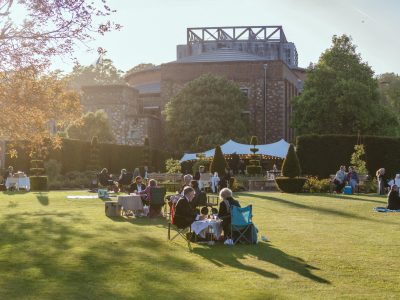
Mixing the old & the new
Head gardener Kevin Martin explains how he sees the gardens as the ‘seventh production’ in every Festival.
The gardeners will be mowing more paths and spaces into the long grass beside the lake so that people can venture further from the main lawn in summer to wander and to picnic. There is a beautiful new Alison Crowther-designed bench around the large beech tree on the far side of the lake. It encircles the tree’s trunk and provides a peaceful and shaded spot from which to look back over the gardens and towards the opera house.
The planting scheme will evolve over winter; each border and bed ebbs and flows at different times to give the longest season of interest. The familiar garden highlights remain, such as the Eremurus or foxtail lilies and the Blue Border starring in the early to midsummer, and the roses in the Mary Christie Rose Garden in June and July. The Long Terrace planting with Persicaria, dahlias and asters features long enough into autumn to offer a glorious scene for Open Gardens visitors and Tour audiences. The gardens set the scene for an even longer period, with Christmas trees greeting visitors to the Christmas concerts, followed in spring by snowdrops and early flowering Narcissus appearing in time for audiences of the new youth opera, Pay the Piper, in February.

Unforeseen circumstances have influenced change in the garden too. During the 2020 lockdown the reduced garden team, working fewer hours, meant that the seeds of native species trees like hazel, and later introductions like sycamore and walnut, found their way into the borders and germinated and were not weeded out as they usually would have been. However, once the team was back at full strength, the gardeners could pot those seedlings up with the idea of replanting them into woodland to compensate for some of the ash trees lost to ash dieback disease and encourage a more mixed, diverse woodland. And as the effects of the pandemic limited audience sizes, the gardens were a bit quieter than usual in 2020 and 2021, which has encouraged visiting wildlife in the gardens to stay on. Kevin has seen more yellow wagtails, firecrests, treecreepers and nuthatches than ever before.
However audiences experience the gardens in 2022, they can be sure that ‘the seventh production’ will receive the same attention to detail as anything seen on stage.
This article was written by Vicky Skeet (Glyndebourne’s rights and content coordinator). It first appeared in Recit – the Glyndebourne Member magazine.
Image credits: James Bellorini












